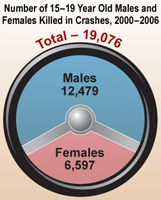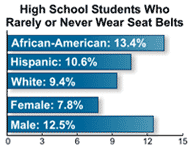Teen Driving Data & Statistics
On this Page
Fatal Teen Crashes

Motor vehicle crashes are the leading cause of death for U.S. teens, accounting for more than one in three deaths in this age group.
Among teen drivers, those at especially high risk of crashing are:
- Males: From 2000 to 2006, the number of male drivers and passengers ages 15 to 19 who were killed in crashes was higher (12,479) than the number of female drivers and passengers who were killed (6,579).
- Teens driving with teen passengers: Driving with teen passengers increases the crash risk of unsupervised teen drivers. This risk increases with the number of teen passengers.
- Driving at night: The crash risk for teens driving at night is nearly twice as high as the crash risk during the day.
- Newly licensed teens: Crash risk is highest during the first year that teens are eligible to drive.
Teen Seat Belt Use

Compared with other age groups, teens have the lowest rate of seat belt use. In 2005, 10.2% of high school students reported they rarely or never wear seat belts when riding with someone else.
CDC Morbidity and Mortabilty Weekly Reports (MMWRs)
Drivers Aged 16 or 17 Years Involved in Fatal Crashes — United States, 2004-2008
(Published October 21, 2010)
Announcement: National Teen Driver Safety Week — October 17-23, 2010
(Published: October 21, 2010)
Youth Risk Behavior Surveillance — United States, 2009
(Published June 4, 2010)
Announcements: Click It or Ticket Campaign — May 24-June 6, 2010
(Published May 21, 2010)
QuickStats: Motor-Vehicle Traffic* and Poisoning† Death Rates,§ by Age — United States, 2005-2006
(Published July 17, 2009)
Injuries Resulting from Car Surfing — United States, 1990-2008
(Published October 17, 2008)
Additional Data Sources
Web-based Injury Statistics Query and Reporting System (WISQARS)
www.cdc.gov/injury/wisqars
WISQARSTM (Web-based Injury Statistics Query and Reporting System) is an interactive database system that provides customized reports of injury-related data.
Youth Risk Behavior Surveillance System (YRBSS)
www.cdc.gov/HealthyYouth/yrbs
The Youth Risk Behavior Surveillance System (YRBSS) monitors priority health-risk behaviors among youth and young adults. The YRBSS includes a national school-based survey conducted by the Centers for Disease Control and Prevention (CDC) and state, territorial, tribal, and district surveys conducted by state, territorial, and local education and health agencies and tribal governments.
Behavioral Risk Factor Surveillance System (BRFSS)
www.cdc.gov/brfss/
The Behavioral Risk Factor Surveillance System (BRFSS) is the world’s largest, on-going telephone health survey system, tracking health conditions and risk behaviors in the United States yearly since 1984. Currently, data are collected monthly in all 50 states, the District of Columbia, Puerto Rico, the U.S. Virgin Islands, and Guam.
CDC WONDER (Wide-ranging Online Data for Epidemiologic Research )
http://wonder.cdc.gov
WONDER an easy-to-use, menu-driven system that makes the information resources of the Centers for Disease Control and Prevention (CDC) available to public health professionals and the public at large. It provides access to a wide array of public health information.
CDC Data & Statistics
www.cdc.gov/DataStatistics
The CDC Data & Statistics web site features interactive tools, surveys, publications, databases, and more.
Get email updates
To receive email updates about this page, enter your email address:
Contact Us:
- Centers for Disease Control and Prevention
National Center for Injury Prevention and Control (NCIPC)
4770 Buford Hwy, NE
MS F-63
Atlanta, GA 30341-3717 - 800-CDC-INFO
(800-232-4636)
TTY: (888) 232-6348
New Hours of Operation:
8am-8pm ET/
Monday-Friday
Closed Holidays - cdcinfo@cdc.gov





